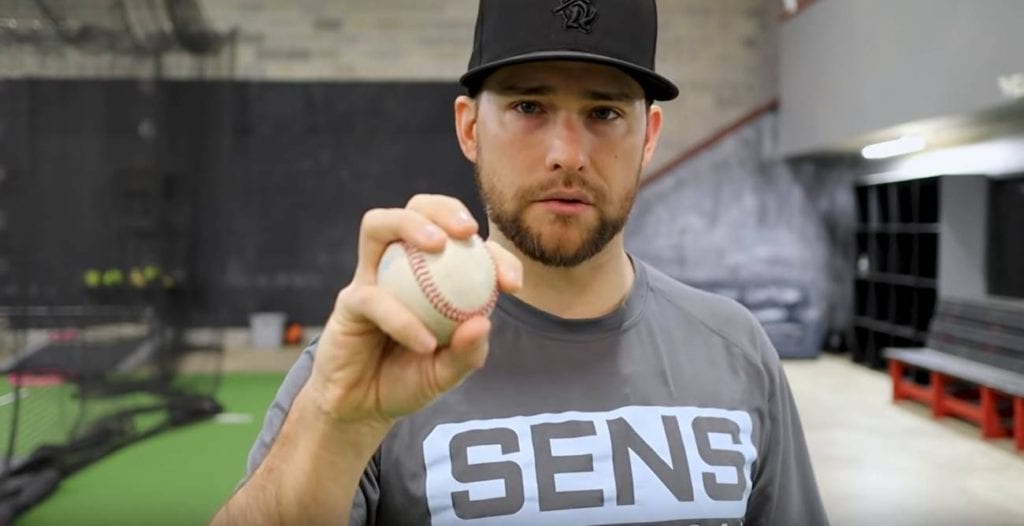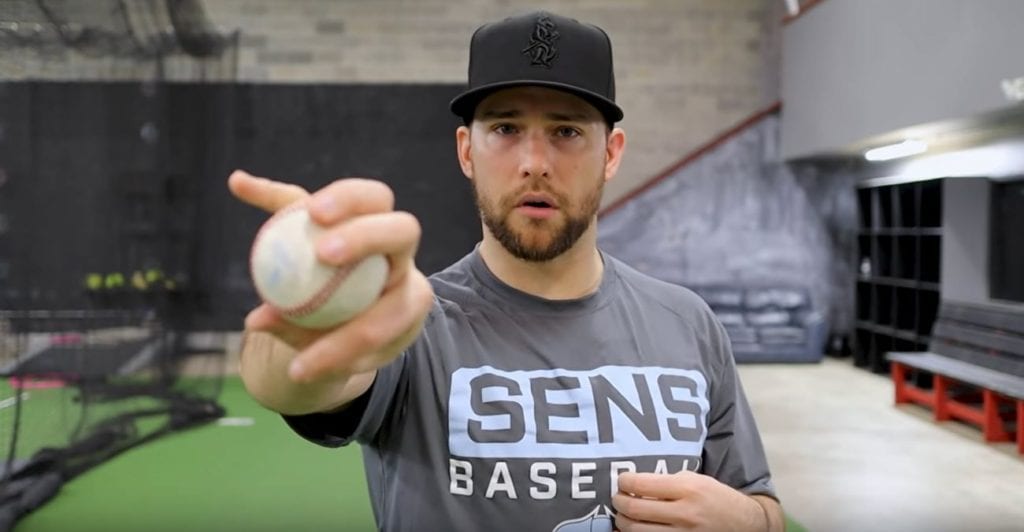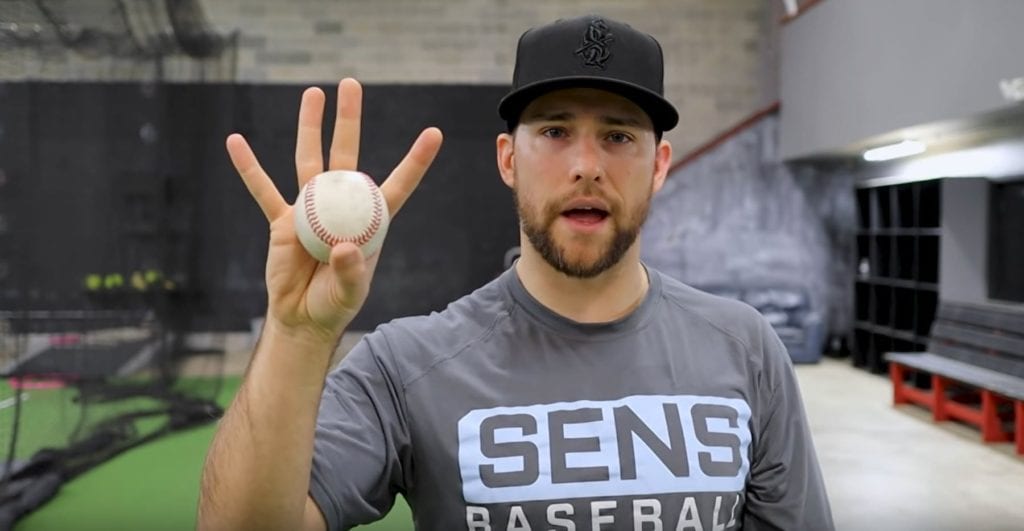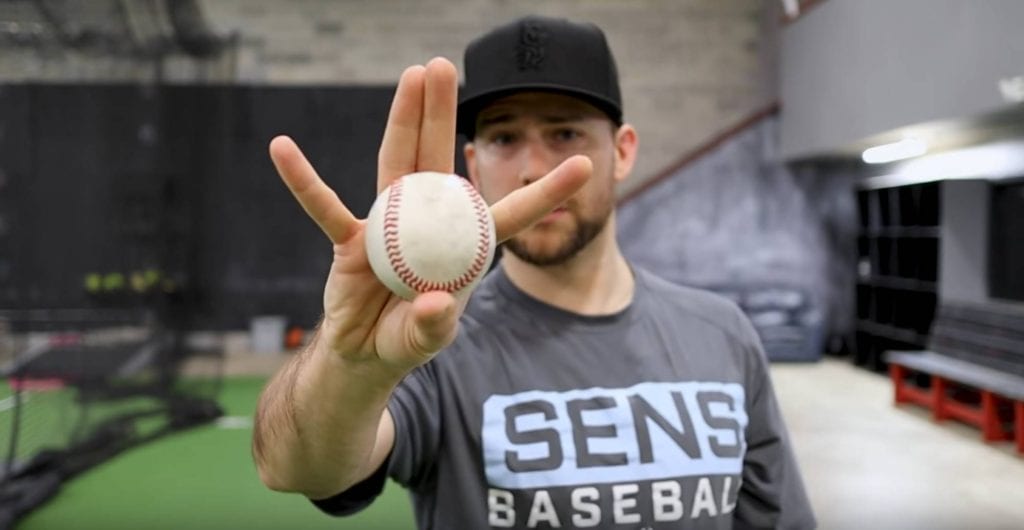*This article may contain product links which pay me a small commission if you make a purchase. Learn more.
How do I throw a changeup? What’s the best way to start throwing this critically important pitch? Lots of amateur players and parents have this question.
In this guide to throwing a changeup, we’ll dive into the grips, the arm action, spin, hand action and much more. You’ll learn everything you need to know to throw one that sinks and runs with great deception and arm speed.
As a pitching coach, one of my biggest tasks is overhauling a pitcher’s off-speed pitches. Most pitchers can’t throw an effective changeup, curveball or slider. The changeup is especially hard to learn because it doesn’t have an easily-observed break like other pitches. So, it’s less visually fun to throw for young players and gives less feedback as well.
But today, we’ll bust some changeup myths and give you all the tools to throw a great one.
Skip to a Section Below
Jump to a section or read on!
1 | How to Throw a Changeup The “Modern” Way
The changup I teach has heavy sink and armside run. If you work hard practicing it and improving over time, yours will have similar movement to the changeups thrown by Kyle Hendricks and Johnny Cueto.
No, I’m not blowing smoke–I’ve taught lots of pitchers over the years, and it’s not hard to produce a heavy sinking changeup. The version I threw in college and pro ball moved as much as both of these accomplished MLB pitchers. It takes a lot of skill to make it to the Majors, and a great offspeed repertoire is part of that.
This article from Forbes details whiff rate for 2019 MLB pitchers, so check it out to learn about some of the best MLB changeups from last year.
Watch below to see if this is the type of pitch you’d like to learn. If so, then stick with me!
More and more pitchers in the Major Leagues are throwing changeups with hard sink and run. It’s time we all start learning this same type of pitch.
2 | Why Is Throwing a Good Changeup So Confusing?
I had this conversation with a friend of mine who is a scout and former Big Leaguer. His thought?
It’s not as cool-looking to throw with your buddies.
When learning a breaking ball, we get feedback by watching it break before our eyes, and our throwing partner gives us feedback from his point of view (that one was sharp!).
But with a changeup, the feedback I give while playing catch with a pitcher is different. I don’t use a radar gun most of the time, and they won’t have access to one either. We go by spin, how it comes out of their hand, their arm action and speed, etc.
The only feedback a pitcher gets when working on his changeup is:
- Feel: How it feels off their hand when they throw a good, bad, or mediocre changeup
- Movement: slight run and sink is all they’ll see, and it’s much less significant than any breaking pitch
- Speed-reduction: you learn to sense this over time, but when we get the spin right, we know the speed will also be right.
It’s Hard to Learn Because It’s Hard to Tell When You Throw It Correctly.
The problem is just that if two 13-year-olds are playing catch with their changeups, they don’t get a lot of feedback on how well they’re doing. If they want to learn to throw a changeup well, they need feedback.
Feedback is crucial in figuring out which versions are good and which are bad, and without it, the pitch won’t improve because the percentage of good vs bad changeups won’t skew in the right direction.
And Feedback Is Critical To Learning Any New Pitch in Baseball.
Your goal as a catch partner for someone learning a changeup should be to give feedback over and over, so that they can connect how it feels and looks as they throw it.
That way, even throwing it to their Mom or Dad, a pitcher can feel for good and bad changeups and consistently reinforce his good habits. But, this starts with education on what a changeup is and why it does what it does.
3 | Why Is a Changeup Slower and How Much Slower Should it Be?
It’s important to understand WHY a changeup is slower. I explain to my pitchers that speed reduction comes from two factors, making up a 10% reduction in speed:
A Changeup Should Be 10-12% Slower Than a Fastball

It’s important to not think about the changeup as having a set MPH reduction, because this couldn’t possibly be the same for a 13-year-old pitcher and a 19-year old. They throw very different speeds, so it’s best to think of a changeup as having a scaling, percentage-based speed reduction:
10% or so. The Changeup should be 10-12% slower than a fastball. Why 10%, give or take?
Because any slower than this and the arm has to begin slowing down–it’s very rare to see pitchers throw a pitcher much slower than 10-12% with their normal delivery and full arm speed.
The Ball Comes Out 5% Slower Because of the Grip
The ball is held deeper by the middle and ring fingers, which are less powerful as a combination than the index and middle. When you learn to throw a changeup, the grip is about half the equation.
And an Additional 5% Slower Because of the Spin You Apply to It.
The grip helps us remove speed from a changeup while simultaneously applying spin to it. This is crucial, as yes, any changeup grip could work, but not all grips will help a pitcher easily spin the ball and produce excellent movement.

The hand pronates inward, slightly, before release. This converts some of the arm speed into spin, which reduces the ball’s speed in the same way as a curveball or slider (except the spin is applied to the opposite side of the ball).
This second 5% is important not only in reducing the pitch’s speed, but in also making the the changeup sink and run to the armside.
4 | The Best Changeup Grip to Use
I taught myself how to throw a changeup in my junior year in college, and it became my best pitch in pro baseball.
As it turns out, the changeup method I teach is incredibly easy to learn for pitchers of all ages, and it starts with the grip. Yet, the grip is just one piece of the puzzle, as the hand action is more important.
The grip, shown below, is really a hybrid between the “circle” change and other grips.
Mine would sink so much that from the dugout (side view) it was often mistaken for a slider or curveball by teammates (atta boy, nice curveball!). Hitters often ask me what the pitch is, because the movement is so significant–it had a lot of screwball-type qualities.
#1. Middle and Ring Finger Together in Two-Seam Orientation
Where you place your middle and ring fingers is VERY important – they work together to apply the proper spin, to get the pitch to rotate much like a discoball does.

The middle and ring finger MUST be close together. This allows them to work together, as a unit, to turn inward on the ball, to make it sink and run.
They, together, accomplish this task of applying spin and speed over and inward on the ball. If the middle and ring finger are apart, they start to work against each other, causing the ball to have inconsistent spin that often cuts.
#2. Thumb Must be Pointing Toward the Two Middle Fingers, Underneath the Ball.
This helps keep the grip loose but firm.

The thumb is the pressure point, and it’s location on the bottom of the ball is crucial. This is because, when on the bottom, it can hold the ball firmly in place against the bottom bridge of the fingers. We DON’T want pressure to be on the fingertips, but rather at the very bottom of the fingers.
This allows the ball to roll farther off the fingers as its released, increasing spin. This is a key part of the changeup grip.
Having the thumb underneath also allows pitchers to throw the ball as hard as they can without constantly spiking it. The test is, the ball is still held in place with all four fingers straightened.
Spiking a changeup is caused by the finger tips hooking it into the ground. If the ball is held by the thumb, it keeps it down longer, reducing the likelihood the fingers will hook it into the ground. My pitchers don’t spike changeups very much.
#3. Pinky and Index Fingers est on the Side of the Baseball
There is no need to “circle” the fingers – it provides little to no benefit.
Rather, the pink and index finger comfortably rest on the side of the ball, as they don’t have a strong role. The middle and ring finger do the job of turning the ball inward (pronating over it), and the thumb holds it in place.

The pinky and index are bystanders. The goal is to not make the hand tense by stretching the pink or index down the ball – this is why making a circle with the index finger is detrimental, at least on this grip, as it will make the whole hand tense.
5 | When To Throw a Changeup
Okay, so once you learn this shiny new pitch, it’ll be important to understand when and why you should throw a changeup. Situational pitching is huge.
First, definitely check out this video below, as it delves deep into the philosophy of throwing a changeup behind in the count. This tactic is HUGE and is a major reason why the changeup is so effective.
Just remember: even the nastiest pitch still needs to be thrown at the right time in an at-bat to maximize its effectiveness.
6 | Troubleshooting Your Changeup
It’s not easy developing a great changeup (or any offspeed pitch for that matter). Practice is key, but to throw a changeup really well, we want to employ some strategies.
One of the biggest frustrations for pitchers new to the changeup is that they bounce it too much. This usually happens for a few reason:
- The grip doesn’t work well for them (tinker and try others)
- They’re gripping it too tightly
- Without the thumb on the bottom, they’re forced to tense their hands up to keep the ball secure
- They’re nervous about throwing it
- They’re “guiding” it and not throwing it like a normal fastball
Watch the video below for some more great troubleshooting tips related to bouncing it.
It’s critical to remember that early on in the learning process, bouncing your changeup will be somewhat normal. Making adjustments is crucial to your longterm success.
Your Overall Pitch Repertoire
Make sure you’re throwing a repertoire that fits your body, your arm slot, your pitching style and age level.
Too many pitchers throw too many pitches. Others choose pitch types that just don’t make sense, which I cover in the video below.
Be sure to make smart choices regarding your career and your development as a ballplayer!
7 | Changeup & Changeup Grips FAQ
How do you hold a changeup?

Put your thumb on the bottom of the ball and your middle and ring fingers together. Lay the middle and ring fingers together between the two-seams, with the thumb on the bottom pointing right at them. Then, let your index and pinky fingers fall gently to the side of the ball. Pressure should be from the thumb to the bottom of the middle and ring fingers.
When should you throw a changeup?
It’s an effective pitch pretty much anytime it’s thrown, but throwing a changeup in fastball counts is the most effective. A fastball count is a count when it’s a little more high-risk to throw an offspeed pitch (which are harder to control). Examples of fastball counts are 0-0, 1-0, 2-0, 3-0, 2-1, 3-1, and 3-2. Throwing a changeup when a hitter expects fastball is a great way to get a quick rollover ground ball for an out
What is a changeup supposed to do?
A changeup should be slower than a fastball by 10-12%, which means if you throw 70mph, a changeup should be 7-8 miles per hour slower (62-63mph). The changeup should also sink and run, which is movement to the pitcher’s armside of the plate. This sinking, running action is critical in giving the hitter not only a speed change to try to figure out, but also a moving pitch to content with.
How do you throw a changeup in Little League baseball?
There should be no difference in the way a little leaguer or other youth pitcher throws a changeup, as compared to a high-level or Big Leaguer. The grip will be the same and the arm and hand action applies just the same no matter the age of the player. Hold the ball at the base of your middle and ring fingers, then put your thumb on the bottom. Fold your other two fingers down the sides, and turn the ball inside as you release like you’re pouring out a can of Coke.
Is a changeup a breaking ball?
Not technically. The way I teach the “modern” changeup in this article, it will produce movement to the armside, with sinking action as well. So technically, it does break. But, breaking balls are typically the slider, curveball and cutter–pitches that their primary purpose is to break by curving or cutting. So the answer here is kind of, but the changeup really isn’t technically a breaking ball.
Whats the best changeup grip?
The changeup grip I teach in this article is very easy to learn and produces a heavily-sinking changeup with armside movement. Yet, there is no best changeup grip. You should be tinkering with this grip and any other you try and see what works best for you to produce the best possible result. There is no one way to skin this cat!
Why do you call it the "modern" changeup?
The changeup was traditionally just a pitch that was slower–it was straight and slower, that was it. Now, Pitch F/X and Trackman grading of pitches has shown us that a changeup with more movement is harder for hitters to hit, even if the speed change is less. So, you see more MLB pitchers throwing changeups that are harder (8-12% slower than their fastball) but with lots of downward movement.
What happens if I throw a changeup too hard?
It just won’t get hitters out on their front foot enough–the speed change won’t be enough to really throw off their timing. They’ll get more of the barrel to the ball than if your changeup meets that “10-12% slower than the fastball” criteria that I outlined before.
Who throws the best changeup in the MLB?
I’d say Stephen Strasburg–it has such crazy sink and armside run, I’m not sure how anyone ever hits it. I also loved Felix Hernandez’s changeup and Kyle Hendricks’ as well. My All-Time favorite was Johan Santana, though his relied more on greater speed change (15% or so) than movement. But Santana just threw it with such deceptive arm speed, and then it came out super slow. It was awesome.
Got a Question? Leave a Comment and Contact Me.
As you can probably tell, I love the changeup and love teaching it. I wrote an article on Elitebaseballperformance.com on the same topic, so check that out as well.
And, don’t forget to sign up for my free newsletter, using the form below. I send out great new information each week on all things baseball. It’ll help you a ton.
Thanks for reading! – Coach Dan
